
Jim and I arose and checked out of the Tacoma Dome Motel, then drove over to the Best Western for breakfast with Bob and Chris. Jim dropped me off at Freighthouse Square while he parked the car in one of the two large parking structures.

A Sounder train was in the station.


This train had F59PHI 911, built by Electro-Motive Division in 2001, in a Seattle Mariners Home Run Service paint scheme. Jim and I waited in front of Freighthouse Square, talking with Bart and Sarah Jennings, as well as Bart's parents, who were joining the trip today. Chris and Bob arrived a few minutes later and at 7:34 AM, we all boarded the first of three chartered buses for the fifty-eight mile drive to Morton. On the way there, as we neared Elbe, it started to rain. Once at the train, I stowed my bags in the covered open car before going outside. Elizabeth Davidge from Victoria, British Columbia, had driven from Lynnwood to Tacoma, and was on the second bus this morning.
A Brief HistoryThe Mt. Rainier Scenic runs over the tracks built by the Tacoma Eastern Railroad Company between the years of 1902 and 1910. The railroad was incorporated on July 14, 1890. On December 31, 1918, while under the control of the United States Railroad Administration, the Milwaukee Road absorbed all of its subsidiary roads, including the Tacoma Eastern, into the Chicago, Milwaukee & St. Paul Railroad system. It was the only profitable branch on the entire Milwaukee Road Pacific Extension. The CM&SP railroad was closed down in 1980, and many of the lines in Washington were abandoned, including this one.
The Mt. Rainier Scenic Railroad is based out of Elbe, Washington started running excursions in the summer of 1981. They ran dinner trains for a few years before the line to Morton was not used as and was essentially abandoned for about 10 years. In 2003, two trestles had to be rebuilt in order to return the Mt. Rainier Scenic Railroad trains to the historic Morton Depot in 2003.
The Trip 6/8/2006
Our train to Tacoma today had Mt. Rainier Scenic Heisler 91, open car 541 and Tacoma Rail coaches 40010, 40020 and 40030, all originally Pennsylvania Railroad.


West Fork Lumber Heisler 91 built by Heisler Locomotive Works in 1922. Invented by Charles Heisler in 1892, the design combined the flexibility of a geared locomotive with increased speed, a key advantage over its major competitors, the Shay and Climax. When the Willamette locomotive was introduced in 1922, Heisler was the first victim of this new competitor. The Coos Bay Lumber Company of Coos Bay, Oregon, had ordered a new 3-truck Heisler in early 1922 but cancelled the order when Willamette sold them their first geared logging locomotive.
At first, neither Lima, builder of the Shay, nor Heisler took Willamette's competition seriously but, as the company's business grew, both manufacturers decided they had to do something. Lima developed its Pacific Coast Shay and Heisler its West Coast Special incorporating refinements that were standard in the Willamette, including all-weather cabs, girder frames, super-heaters and piston valves. The West Coast Special was the largest and most advanced Heisler ever built. The Whitney Engineering Company in Tacoma, the West Coast dealer for Heislers, ordered this three truck locomotive in 1929 as stock.
Two years later, Whitney sold the engine to the Kinzua Pine Mills in Kinzua, Oregon, where it was numbered 102. When Kinzua began dieselisation in the 1950's, while its Shays were scrapped, 102 was retained as back-up to the diesels. By the early 1960's, however, the Heisler had outlived its purpose and was sold and shipped to the Vernonia South Park & Sunset tourist railroad in Vernonia, Oregon. However, 102 never steamed at Vernonia. In 1965, it was sold to Clyde Schurman, a machinist who displayed the engine at his machine shop in Woodland, Washington.
In 1978, it was sold to Tom Murray Jr., who donated the locomotive to the MRSR. Renumbered 91 in honour of an earlier three truck Heisler that worked out of Mineral for the West Fork Logging Company, an operation founded by the father of Tom Murray, it was the second engine restored to operation at Mineral.
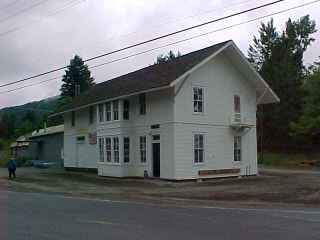
Dave Arthur and I walked to find the relocated Chicago, Milwaukee. St. Paul and Pacific Morton Depot, built in 1910 and had been the subject of a major television program. We then set up for a start-up photo runby but had to wait for Bus 3 to arrive from Tacoma.

We had a practice runby with a forklift before a quick rain shower passed through. Bus 3 finally arrived and we were ready for the first photo runby of the day.

Heisler 91 started moving forward.





Photo runby one was our train steaming by us. What a great way to start a trip! We all boarded before the train was reversed toward the end of the track by the Morton depot.

Our train reversed across Highway 7 to the end of track, then we started the trek to Tacoma.


Now we started the climb to Divide.



A few minutes later we crossed the East Fork of the Tilton River on a nine degree left hand curve.


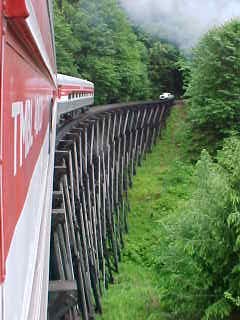
Shortly afterward, we crossed Nineteen Creek at Milepost 61.3 on the other high curved bridge and continued our trek to Divide, with Heisler 91 working very hard. We stopped at the Tilton River trestle at MP 58.4 for next photo runby.

The photo runby line below my location.
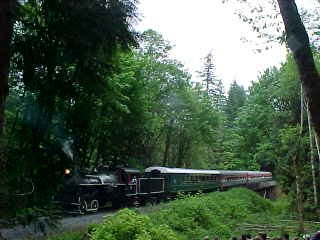
The reverse move.

Photo runby two was the train crossing the Tilton River trestle.

The Heisler put on a fantastic show starting on the grade then slipping before going into the "I think I can! I think I can!" mode. The train made it over Divide then descended to Mineral.
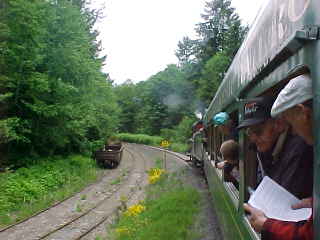
We passed the loop track that the regular Mt. Rainier Scenic trains use on their Elbe-to-Mineral excursions.

This is where the loop returns to their mainline.

We passed the switch with the line to the shops which I rode over in July 2005 during the National Railway Historical Society convention excursion.
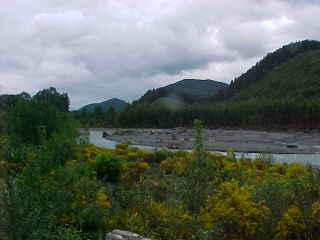
We proceeded to the Nisqually River to perform photo runby three.

The reverse move.


Photo runby 3 was our train crossing the Nisqually River at Milepost 48.5. Back aboard, we continued on to Elbe by crossing Highway 706.

Park Junction at Milepost 48.0. This is the junction with the short (once six miles long, but not three) branch eastward to National and Ashford near Mount Rainier National Park. The Tacoma Eastern first reached this location in 1904 and built eastward before building south into the coal fields.
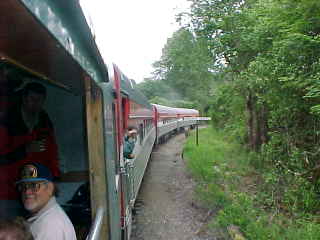
We curved through Park Junction before arriving at Elbe, our water stop of the day.



Heisler 91 at Elbe.
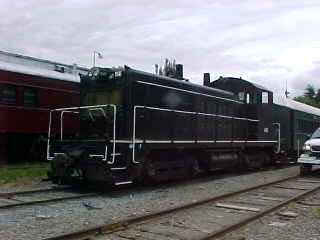
Mount Rainier Scenic Railroad NW2 481, ex. Louis Dreyfus 481 1990, exx. Cargill 103 1982, exxx. Pacific Transportation Services 103 1982, exxxx. Burlington Northern 481, exxxxx. Great Northern 1713, nee Great Northern 5336, built by Electro-Motive Division in 1942, was about to leave before us bound for Fredrickson with a lone coach.

I walked over to the edge of Alder Lake.

An unofficial photo runby with the switcher as it departed.


Photo runby four was the steam train running through the yard. We all reboarded and proceeded towards Tacoma, starting my new mileage. When Alder Lake was made, the tracks had to be relocated on a new one percent grade to New
Reliance, so I knew Heisler 91 would be working hard again./P>

Our train crossed Washington Highway 706 to start the run up the grade.

The Heisler was working hard on the grade towards Alder Lake and New Reliance.

Alder Lake. We climbed the grade to New Reliance.

Countryside.

The Scotch Broom was in bloom here as well.

A farm along our route.

Our ever-present rear hi-rail vehicle protection was now running ahead of us to turn on the crossing signals as we made our way to Tacoma.

We crossed the Big Mashel River at Milepost 34.2, on a 85 foot deck plate girder with 13 spans of frame and pile bents. This river was known by pioneers as Michels Fork of the Nisqually River. Mashel is Indian meaning "place of dark shadows in the water". Mashel has been spelt a number of ways, including Mishell and Mishall.

Rolling toward Eatonville.

Our train approached Concrete Bridge at Milepost 36.0 and due to low clearance problems with the undercarriage of the passenger cars, we were slowly walked over this bridge.

Creeping across the Concrete Bridge over the Mashel River under many watchful eyes.

Crossing the bridge.


Mashel River.




We safely crossed the concrete bridge and proceeded to Eatonville, where we were allowed off the train while Heisler 91 was serviced.

The rear of our train coming off the bridge.


After servicing, we were on the way to Fredrickson.

Running west down the valley.


Passing Lake Kapowsin.

Curving through Tanwax at Milepost 22.6. The name origin was connected to the narrow valley in the area, which in the local Indian language was "tunwax". The Tanwax and Western Railroad built in the area in 1915, acquired by the Milwaukee Raod (to Western Junction) and abandoned by World War II. A 2,023 foot siding existed here for many years.

Leaving Tanwax as we approached civilization.

We saw several horses enjoying our passage.


The train curved through Thrift at Milepost 19.5.

Our group on the train. Left to right: Chris Parker, Bob Riskie, the author and Jim Nowell. Photograph by Elizabeth Davidge.

Nearing Fredrickson.


When we arrived at Fredrickson, Tacoma Rail SD45 3001 was ready to assist us down Tacoma Hill, so we stopped to add the SD45 to the head of our train then at the rear, the coach that the switcher had brought from Elbe was coupled.

After departing, our train came to the junction with the Tacoma Rail line that heads west out of Fredrickson and was on its way to Tacoma Hill.

Passed through Hillsdale at Milepost 5.1, which was settled by mostly German families starting in 1886. Originally named Bismark (for Prince von Bismark-Schonhausen, once Chancellor of the German Empire), the name was changed to Hillsdale (named for the hilly terrain that the town sat on) in 1918. The Tacoma Eastern's main shops and storehouse were located here but were moved to the Milwaukee's own shops near Tacoma by 1910.
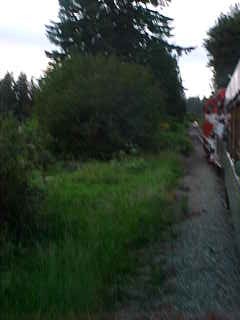
Passing through several Tacoma neighbourhoods.

Next we started down the four percent grade of Tacoma Hill, which was interesting with the large SD45 dwarfing Heisler 91.

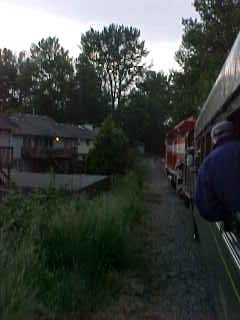
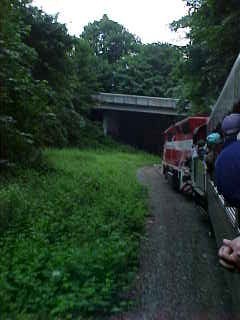
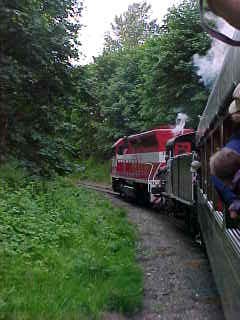






The journey down the steep Tacoma Hill.


We reached the CTC signal at the bottom and curved to our unloading location.
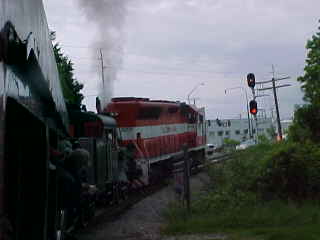
The train arrived and we all detrained, ending our last rare mileage trip sponsored by the Southern Appalachia Railway Museum. A special thank you to Bart and Sarah Jennings for all their hard work that made our trips so fantastic this year. I said my goodbyes to my fellow rare mileage travellers.

Our train after we had arrived.
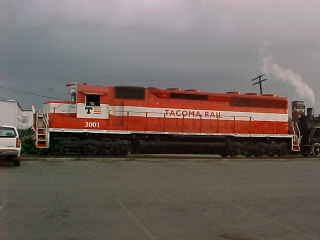
Tacoma Rail SD45 3001, ex. National Railway Equipment 6564, exx. Chicago and North Western 6564, exxx. Conrail 6237, nee Penn Central 6237 built by Electro-Motive Division in 1968.

A former Milwaukee Road grade crossing signal.

Jim drove up with the car and we all went to the Harbor Light Restaurant where we enjoyed a fantastic dinner with a Tacoma Harbor and BNSF mainline view to keep it interesting. We drove Chris and Bob back to the Best Western before Jim and I returned to the Tacoma Dome Motel for the night, and Elizabeth returned to Lynnwood for the evening.
| RETURN TO THE MAIN PAGE |